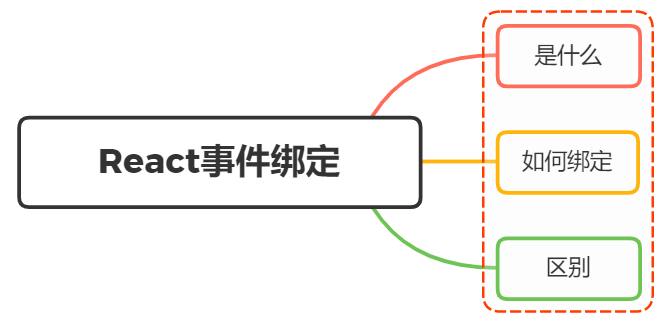# 面试官:React事件绑定的方式有哪些?区别?

# 一、是什么
在react应用中,事件名都是用小驼峰格式进行书写,例如onclick要改写成onClick
最简单的事件绑定如下:
class ShowAlert extends React.Component {
showAlert() {
console.log("Hi");
}
render() {
return <button onClick={this.showAlert}>show</button>;
}
}
从上面可以看到,事件绑定的方法需要使用{}包住
上述的代码看似没有问题,但是当将处理函数输出代码换成console.log(this)的时候,点击按钮,则会发现控制台输出undefined
# 二、如何绑定
为了解决上面正确输出this的问题,常见的绑定方式有如下:
- render方法中使用bind
- render方法中使用箭头函数
- constructor中bind
- 定义阶段使用箭头函数绑定
# render方法中使用bind
如果使用一个类组件,在其中给某个组件/元素一个onClick属性,它现在并会自定绑定其this到当前组件,解决这个问题的方法是在事件函数后使用.bind(this)将this绑定到当前组件中
class App extends React.Component {
handleClick() {
console.log('this > ', this);
}
render() {
return (
<div onClick={this.handleClick.bind(this)}>test</div>
)
}
}
这种方式在组件每次render渲染的时候,都会重新进行bind的操作,影响性能
# render方法中使用箭头函数
通过ES6的上下文来将this的指向绑定给当前组件,同样再每一次render的时候都会生成新的方法,影响性能
class App extends React.Component {
handleClick() {
console.log('this > ', this);
}
render() {
return (
<div onClick={e => this.handleClick(e)}>test</div>
)
}
}
# constructor中bind
在constructor中预先bind当前组件,可以避免在render操作中重复绑定
class App extends React.Component {
constructor(props) {
super(props);
this.handleClick = this.handleClick.bind(this);
}
handleClick() {
console.log('this > ', this);
}
render() {
return (
<div onClick={this.handleClick}>test</div>
)
}
}
# 定义阶段使用箭头函数绑定
跟上述方式三一样,能够避免在render操作中重复绑定,实现也非常的简单,如下:
class App extends React.Component {
constructor(props) {
super(props);
}
handleClick = () => {
console.log('this > ', this);
}
render() {
return (
<div onClick={this.handleClick}>test</div>
)
}
}
# 三、区别
上述四种方法的方式,区别主要如下:
- 编写方面:方式一、方式二写法简单,方式三的编写过于冗杂
- 性能方面:方式一和方式二在每次组件render的时候都会生成新的方法实例,性能问题欠缺。若该函数作为属性值传给子组件的时候,都会导致额外的渲染。而方式三、方式四只会生成一个方法实例
综合上述,方式四是最优的事件绑定方式
# 参考文献
- https://segmentfault.com/a/1190000011317515
- https://vue3js.cn/interview/
